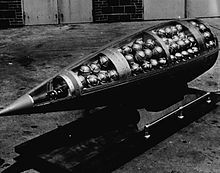M134 bomblet

The M134 bomblet was a U.S. chemical cluster munition designed for use in the MGR-1 Honest John rocket during the 1950s. The weapon was never mass-produced and was supplanted in 1964 by an improved design, the M139.
History
[edit]The M134 bomblet, developed as the E130, or E130R1 bomblet,[1] began development in the early 1950s.[2] While the weapon was not yet battle-ready, or ready for mass-production, in 1960, work on the bomblet dated back to at least 1953.[2] By 1964 the bomblet design had been improved and the smaller M139 was adapted for use with the rocket warheads utilized by the M134.[3] Thus, the M134 was never mass-produced; by the time the missile warhead and the M134 were ready for production they had been supplanted.[1]
Specifications
[edit]The M134 bomblet was designed for the M190 Honest John rocket warhead.[1] The bomblets carried sarin nerve agent and after the missile was fired the bomblets were released 5,000 feet (1,500 m) above their target.[1] At the time of the sub-munitions' release a mechanical time fuze would cut the warhead's skin and the bomblets were released.[1] The weapon could effectively saturate an area 3,300 feet (1,000 m) in diameter with chemical agent.[1]
The Honest John held 356 of the 115 mm M134s.[1] The spherical M134 was 4.5 inches around and constructed of ribbed steel. Its interior held about 1.1 pounds (0.50 kg) of sarin (GB).[2] The U.S. Army Chemical Corps originally planned to use the M134 as a VX dispersement method also, but later regarded this use as ineffective and scrapped the plan.[2]
Issues
[edit]The warhead meant to carry the M134 was classified and went into production on April 14, 1960; the M134, however, was not yet ready for production.[2] The M134 had a host of issues which impeded its development. Problems with the fuze system, and a tendency toward unacceptable pressure build-up in filled munitions were among the problems encountered during development.[2] The problems with the M134 delayed the rocket-delivered nerve agent program.[2] By 1964 the successor M139 bomblet was ready for production.[3] The M139 was superior to the M134: its glide angle of 22° allowed it better agent coverage.[1]
See also
[edit]References
[edit]- ^ a b c d e f g h Kirby, Reid. "The CB Battlefield Legacy: Understanding the Potential Problem of Clustered CB Weapons Archived 2012-10-19 at the Wayback Machine", Army Chemical Review, pp. 25-29, July-December 2006, accessed January 5, 2009.
- ^ a b c d e f g "Summary of Major Events and Problems - United States Army Chemical Corps: Fiscal Year 1960", April 1961 U.S. Army Chemical Corps Historical Office, via Office of Scientific & Technical Information, U.S. Department of Energy, accessed January 5, 2009.
- ^ a b Smart, Jeffery K. Medical Aspects of Chemical and Biological Warfare Archived 2012-08-26 at the Wayback Machine: Chapter 2 - History of Chemical and Biological Warfare: An American Perspective, (PDF Archived 2015-09-23 at the Wayback Machine: p. 51), Borden Institute, Textbooks of Military Medicine, PDF via Maxwell-Gunter Air Force Base, accessed January 5, 2009.
